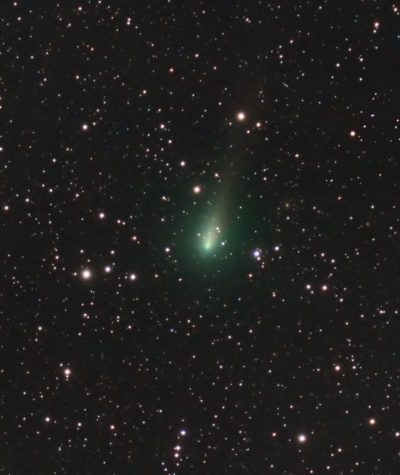Comet C/2019 Y4 ATLAS
 Click image for full size version
Click image for full size version
April 12, 2020
 This image shows Comet C/2019 Y4 ATLAS, high in the northern sky on the evening of April 10. There are other interesting objects in the field, including LBN 702, the large brownish dust cloud dominating the lower left of the image. I couldn’t bring it out much more without revealing noise from the very short acquisition times. There are also many galaxies, some of which are marked in the annotated image. Note edge-on spiral galaxy PGC19652, towards upper left. Its disk appears slightly bent, with the tips going in different directions.
This image shows Comet C/2019 Y4 ATLAS, high in the northern sky on the evening of April 10. There are other interesting objects in the field, including LBN 702, the large brownish dust cloud dominating the lower left of the image. I couldn’t bring it out much more without revealing noise from the very short acquisition times. There are also many galaxies, some of which are marked in the annotated image. Note edge-on spiral galaxy PGC19652, towards upper left. Its disk appears slightly bent, with the tips going in different directions.
Tekkies:
Acquisition, focusing and control of Paramount MX mount with TheSkyX. Focus with Optec DirectSync motor and controller. Automation with CCDCommander. Equipment control with PrimaLuce Labs Eagle 3 Pro computer. All pre-processing and processing in PixInsight. Acquired from my SkyShed in Guelph. Minimal moonlight, above average transparency and average or better seeing. Acquired April 10, 2020.
Luminance: Sky-Watcher Esprit 150 f/7 refractor and QHY 16200-A camera with Optolong UV/IR filter
Chrominance: Takahashi FSQ-106 ED IV @ f/3.6 and QHY367C one-shot colour camera with Optolong L-Pro filter
Chrominance: 12 x 3m = 36m
Total: 1 hour
Data Reduction and Processing
Preprocessing: The WeightedBatchPreProcessing script was used to create a Lightness master frame (from the mono camera) and a RGB master frame (from the one-shot colour camera). A second Lightness master was made from just three 2m subs, centred on the same time of acquisition as the larger stack. MURE Denoise was applied to both Lightness masters, and the comet from the smaller stack was cloned into the larger stack, tightening up the comet.
Gradient Removal: DBE was applied to Lightness and RGB masters using Subtraction to remove the gradient that remained after integration.
Colour
Channel Registration: To improve channel registration, the colour channels of the RGB master were extracted and aligned with StarAlignment, using Thin Plate Splines with Distortion Correction and the green channel as the reference frame. The registered colour channels were recombined with ChannelCombination.
Colour Balancing: Colour was balanced with PhotometricColorCalibration.
Linear Noise Reduction: MultiscaleLinearTransform was used to reduce noise in the background areas, using an internal mask to protect bright structures. Layer settings for threshold and strength: Layer 1: 5.0 0.85, 2 iterations; Layer 2: 3.5, 0.75, 2 iterations; Layer 3: 3.0, 0.5, 1 iteration; Layer 4: 1.0, 0.25, 1 iteration.
Stretching: HistogramTransformation was applied to make a pleasing, bright image, with background set to an intensity of approximately 0.10.
Lightness
Linear Noise Reduction: MultiscaleLinearTransform was used to reduce noise in the background areas, using an internal mask to protect bright stars. Layer settings for threshold and strength: Layer 1: 3.0 0.85, 1 iterations; Layer 2: 2.0, 0.75, 1 iterations; Layer 3: 1.0, 0.5, 1 iteration.
Stretching: HistogramTransformation was applied to make a pleasing, bright image, with background set to an intensity of approximately 0.10.
Combining Lightness and Colour Images
Registration of L and RGB: The Colour image was rotated and cropped similar to the Lightness master, and then registered to the Lightness master using StarAlignment.
LRGB Combination: The Lightness image was applied to the RGB image using LRGBCombination with default settings.
Additional Processing
Nonlinear Noise Reduction: TGVDenoise was used in L*a*b* mode to reduce noise with a mask used to target nebula and background and protect the comet and the stars (max. 1000 iterations and convergence selected for both lightness and chrominance).
Final Steps: Brightness, contrast, and colour saturation of various components of the image were adjusted in several iterations using CurvesTransformation with masks as required. ICCProfileTransformation (sRGB IEC61966-2.1; Relative Colorimetric with black point compensation) was applied prior to saving as a jpg.






Leave A Comment